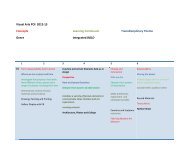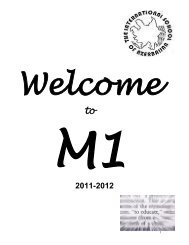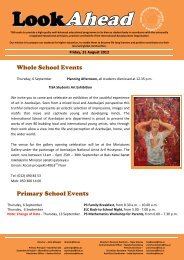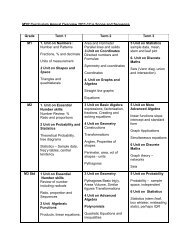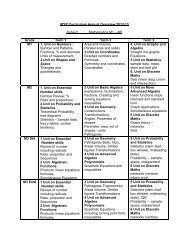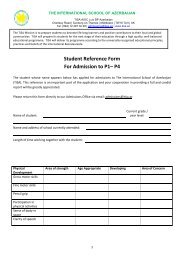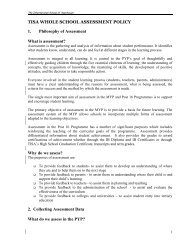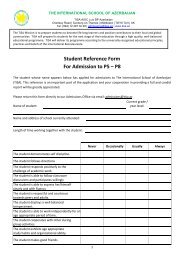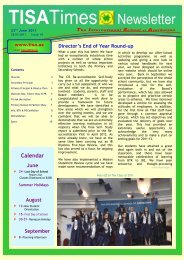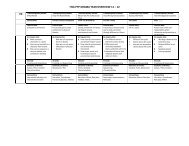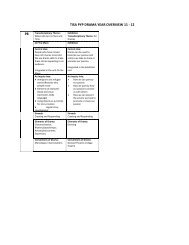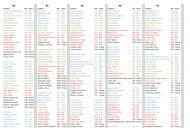The International School of Azerbaijan (TISA) P3 Programme of Inquiry 2013-2014
P3 Year Overview 2013-14 - The International School of Azerbaijan
P3 Year Overview 2013-14 - The International School of Azerbaijan
You also want an ePaper? Increase the reach of your titles
YUMPU automatically turns print PDFs into web optimized ePapers that Google loves.
<strong>The</strong> <strong>International</strong> <strong>School</strong> <strong>of</strong> <strong>Azerbaijan</strong> (<strong>TISA</strong>) <strong>P3</strong> <strong>Programme</strong> <strong>of</strong> <strong>Inquiry</strong> <strong>2013</strong>-<strong>2014</strong><br />
Transdisciplinary<br />
<strong>The</strong>me<br />
Who We Are<br />
An inquiry into the nature <strong>of</strong> the<br />
self; beliefs and values; personal,<br />
physical, mental, social and<br />
spiritual health; human<br />
relationships including families,<br />
friends, communities and cultures;<br />
rights and responsibilities; what it<br />
means to be human.<br />
Where We Are in Place and Time<br />
An inquiry into orientation in place and time;<br />
personal histories; home and journeys; the<br />
discoveries; explorations and migrations <strong>of</strong> man<br />
kind; the relationships between and the<br />
interconnectedness <strong>of</strong> individuals and<br />
civilizations, from local and global perspectives.<br />
How We Express Ourselves<br />
An inquiry into the ways we discover<br />
and express ideas, feelings, nature,<br />
culture, beliefs and values; the ways<br />
in which we reflect on, extend and<br />
enjoy our creativity; our appreciation<br />
<strong>of</strong> aesthetics.<br />
How the World Works<br />
An inquiry into the natural world (physical<br />
and biological) and human societies; how<br />
humans use their understanding <strong>of</strong> scientific<br />
principles; the impact <strong>of</strong> science and<br />
technological advances on society and on<br />
the environment.<br />
How We Organise Ourselves<br />
An inquiry into the interconnectedness <strong>of</strong><br />
human-made systems and communities; the<br />
structure and function <strong>of</strong> organisations;<br />
societal decision-making; economic<br />
activities and their impact on humankind<br />
and on the environment.<br />
Sharing the Planet<br />
An inquiry into rights and<br />
responsibilities in the struggle to<br />
share finite resources with other<br />
people and with other living things;<br />
communities and the relationships<br />
within and between them; access to<br />
equal opportunities; peace and<br />
conflict resolution.<br />
Focus: Easy readers<br />
and what the Level 2<br />
mean. Learning about<br />
the world from fiction<br />
and nonfiction. What<br />
are true stories?<br />
Maths:<br />
integrated in unit<br />
Data Handling<br />
Constructing<br />
Understand that sets<br />
can be organised by<br />
different attributes<br />
Transferring<br />
Represent information<br />
through pictographs and<br />
tally marks<br />
Applying<br />
Apply and create<br />
pictographs and tally<br />
marks<br />
Pattern and Function<br />
Measurement<br />
Measure arbitary unit<br />
Map making<br />
Time – today tomorrow, soon,<br />
later,<br />
Data handling<br />
Shape and Space<br />
Constructing:<br />
Understand that there are<br />
relationships among and<br />
between 2D and 3D<br />
shapes<br />
Understand that 2D and<br />
3D shapes can be created<br />
by putting together and/or<br />
taking apart other shapes<br />
Understand that geometric<br />
shapes are useful for<br />
representing real world<br />
situations<br />
Transferring:<br />
Analyse and describe the<br />
relationships between 2D<br />
and 3D shapes<br />
Represent ideas about the<br />
real world using geometric<br />
vocabulary and symbols<br />
Applying:<br />
Analyse and use what they<br />
know about 3D shapes to<br />
describe and work with 2D<br />
Measurement<br />
Capacity<br />
Data handling<br />
Probability<br />
Estimation<br />
Measurement<br />
Constructing:<br />
understand that attributes can<br />
be compared and described<br />
Understand the use <strong>of</strong> standard<br />
units to measure<br />
Understand that tools can be<br />
used to measure<br />
Transferring:<br />
identify, compare and describe<br />
attributes <strong>of</strong> real objects<br />
Estimate and measure objects<br />
using standard units <strong>of</strong><br />
measurement<br />
Applying:<br />
Describe observations about<br />
events and objects in real life<br />
situations<br />
Use non-standard units <strong>of</strong><br />
measurement to solve problems<br />
in real life situations involving<br />
length and mass<br />
Shape and Space<br />
Pattern/Function<br />
Constructing: Understand<br />
that patterns can be found<br />
in everyday situations e.g.<br />
nature<br />
Transferring: Represent<br />
patterns in a variety <strong>of</strong><br />
ways<br />
Applying: Extend and<br />
create patterns<br />
Shape and Space<br />
Constructing:<br />
Understand that examples<br />
<strong>of</strong> symmetry and<br />
transformations can be<br />
found in their immediate<br />
environment<br />
Transferring:<br />
Identify lines <strong>of</strong> reflective<br />
symmetry<br />
Applying:<br />
Recognise and explain<br />
simple symmetrical<br />
designs in the environment<br />
Updated: 28 August <strong>2013</strong>



